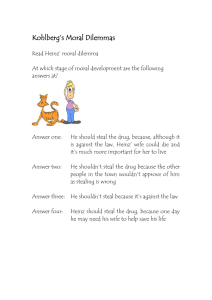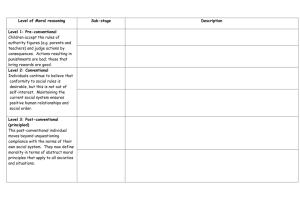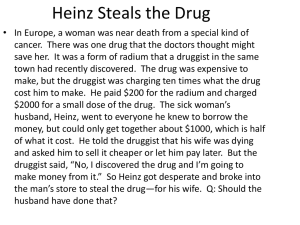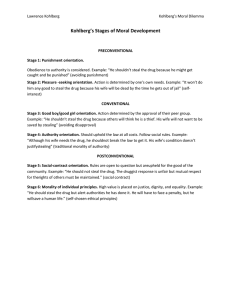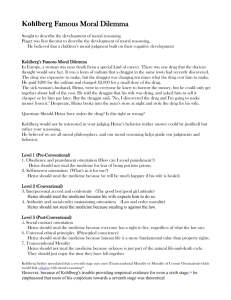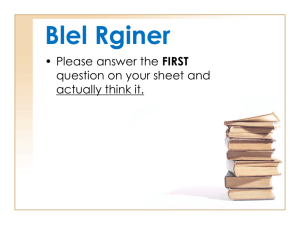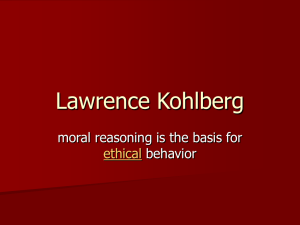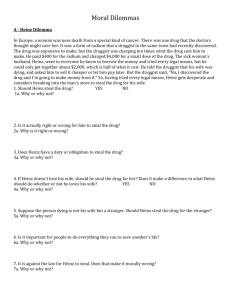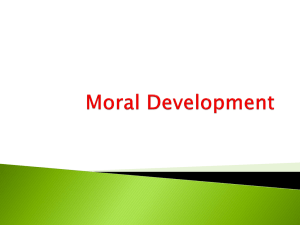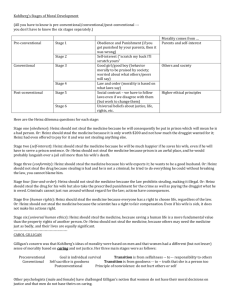Heinz's Dilemma Activity
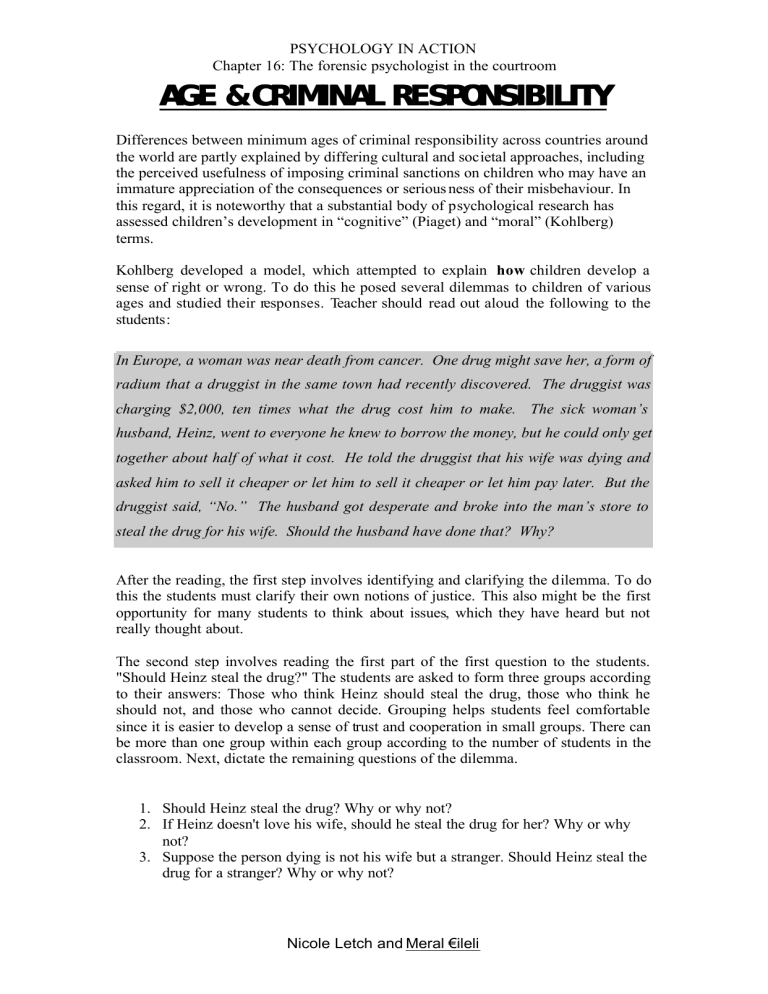
PSYCHOLOGY IN ACTION
Chapter 16: The forensic psychologist in the courtroom
Differences between minimum ages of criminal responsibility across countries around the world are partly explained by differing cultural and societal approaches, including the perceived usefulness of imposing criminal sanctions on children who may have an immature appreciation of the consequences or serious ness of their misbehaviour. In this regard, it is noteworthy that a substantial body of psychological research has assessed children’s development in “cognitive” (Piaget) and “moral” (Kohlberg) terms.
Kohlberg developed a model, which attempted to explain how children develop a sense of right or wrong. To do this he posed several dilemmas to children of various ages and studied their responses. Teacher should read out aloud the following to the students:
In Europe, a woman was near death from cancer. One drug might save her, a form of radium that a druggist in the same town had recently discovered. The druggist was charging $2,000, ten times what the drug cost him to make. The sick woman’s husband, Heinz, went to everyone he knew to borrow the money, but he could only get together about half of what it cost. He told the druggist that his wife was dying and asked him to sell it cheaper or let him to sell it cheaper or let him pay later. But the druggist said, “No.” The husband got desperate and broke into the man’s store to steal the drug for his wife. Should the husband have done that? Why?
After the reading, the first step involves identifying and clarifying the dilemma. To do this the students must clarify their own notions of justice. This also might be the first opportunity for many students to think about issues, which they have heard but not really thought about.
The second step involves reading the first part of the first question to the students.
"Should Heinz steal the drug?" The students are asked to form three groups according to their answers: Those who think Heinz should steal the drug, those who think he should not, and those who cannot decide. Grouping helps students feel comfortable since it is easier to develop a sense of trust and cooperation in small groups. There can be more than one group within each group according to the number of students in the classroom. Next, dictate the remaining questions of the dilemma.
1. Should Heinz steal the drug? Why or why not?
2. If Heinz doesn't love his wife, should he steal the drug for her? Why or why not?
3. Suppose the person dying is not his wife but a stranger. Should Heinz steal the drug for a stranger? Why or why not?
Nicole Letch and Meral €ileli
PSYCHOLOGY IN ACTION
Chapter 16: The forensic psychologist in the courtroom
4. Suppose it is a pet animal he loves. Should Heinz steal to save the pet animal?
Why or why not?
5. Why should people do everything they can to save another's life?
6. It is against the law for Heinz to steal? Does that make it morally wrong? Why or why not?
7. Why should people generally do everything they can to avoid breaking the law? How does this relate to Heinz's case?
Each group discusses and writes down the reasons in answer to the questions of the dilemma, then reports them back to the other groups.
During this process, try to encourage students to find each other's perspective along with the perspectives of the people in the dilemma since role-taking is a prerequisite to the development of moral thinking. Also ask abstract philosophical questions such as, "Why are laws made? On what basis should one decide whether a law is just or unjust? If one decides to break a law intentionally, does a person have a responsibility to accept the consequences?" These questions invite students to explore the reasons behind their views and to interact with their classmates in a way that challenges their reasoning.
What to expect
Kohlberg's research in psychology has shown that our conception of justice-what is right-changes and develops over time as we interact with our environment. Students at the pre- conventional level approach a moral problem from the concrete interests of the individuals involved in a situation. Their concerns will be whether Heinz will be punished for stealing and whether he will be able to live without his wife.
Students at the conventional level approach a moral problem as a member of society and take into account what the group or society expects an individual to do within its moral norms. The students' considerations at this level will focus on 1) whether a loving husband would do whatever he could to save his wife, 2) whether he could get help from the authorities and what would happen to society if all its members broke the laws. The concern is to protect society as well as one's own interests.
At the post-conventional level a moral problem is considered from an above society perspective. The person at this level sees beyond the current laws and norms of society and thinks about the principles upon which a just society can be based. In relation to Heinz's dilemma, the person at the post-conventional level will consider whether the attempts to save a life would be interpreted as breaking the law. Another consideration would be to decide what kind of system could both prevent the loss of innocent life and protect the druggist's right to property.
Nicole Letch and Meral €ileli
PSYCHOLOGY IN ACTION
Chapter 16: The forensic psychologist in the courtroom
A summary of Kohlberg’s findings in terms of age appropriate morality in relation to Heinz’s dilemma.
Kohlberg’s Stages of Moral Development
PRECONVENTIONAL
Stage 1: Punishment orientation.
Obedience to authority is considered.
Example: “He shouldn’t steal the drug because he might get caught and be punished” (avoiding punishment)
Stage 2: Pleasure -seeking orientation.
Action is determined by one’s own needs. Example: “It won’t do him any good to steal the drug because his wife will be dead by the time he gets out of jail” (self- interest)
CONVENTIONAL
Stage 3: Good boy/good girl orientation. Action determined by the approval of their peer group. Example: “He shouldn’t steal the drug because others will think he is a thief. His wife will not want to be saved by stealing” (avoiding disapproval)
Stage 4: Authority orientation.
Should uphold the law at all costs. Follow social rules. Example: “Although his wife needs the drug, he should not break the law to get it. His wife’s condition doesn’t justify stealing” (traditional morality of authority)
POSTCONVENTIONAL
Stage 5: Social-contract orientation. Rules are open to question but are upheld for the good of the community. Example: “He sho uld not steal the drug. The druggist response is unfair but mutual respect for the rights of others must be maintained.” (social contract)
Stage 6: Morality of individual principles. High value is placed on justice, dignity, and equality. Example: “He should steal the drug but alert authorities he has done it. He will have to face a penalty, but he will save a human life.” (self-chosen ethical principles)
Nicole Letch and Meral €ileli
